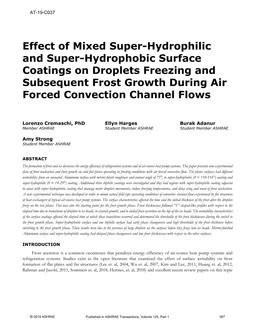
AT-19-C037 — Effect of Mixed Super-Hydrophilic and Super-Hydrophobic Surface Coatings on Droplets Freezing and Subsequent Frost Growth During Air Forced Convection Channel Flows
Click here to purchase
The formation of frost and ice decreases the energy efficiency of refrigeration systems and of air-source heat pump systems. This paper presents new experimental data of frost nucleation and frost growth on cold flat plates operating in frosting conditions with air forced convective flow. The plates surfaces had different wettability: from an uncoated Aluminum surface with mirror finish roughness and contact angle of 75°, to super-hydrophobic (θ ≈ 110-116°) coating and super-hydrophilic (θ ≈ 19-29°) coating. Additional three biphilic coatings were investigated and they had regions with super-hydrophilic coating adjacent to areas with super-hydrophobic coating that manage water droplets movements, reduce freezing temperatures, and delay icing and onset of frost nucleation. A new experimental technique was developed in order to mimic actual field type operating conditions of convective channel flow experienced by fin structures of heat exchangers of typical air-source heat pump systems. The surface characteristics affected the time and the initial thickness of the frost after the droplets froze on the test plates. This was also the starting point for the frost growth phase. Frost thicknesses followed “S” shaped-like profiles with respect to the elapsed time due to transitions of droplets to ice beads, to crystals growth, and to initial frost accretion on the top of the ice beads. The wettability characteristics of the surface coatings affected the elapsed time at which these transitions occurred and determined the thresholds of the frost thicknesses during the switch to the frost growth phase. Super-hydrophobic surface and one biphilic surface had early phase changeovers and high thresholds of the frost thickness before switching to the frost growth phase. These results were due to the presence of large droplets on the surfaces before they froze into ice beads. Mirror-finished Aluminum surface and super-hydrophilic coating had delayed phase changeovers and low frost thicknesses with respect to the other surfaces.
Citation: 2019 Winter Conference, Atlanta, GA, Conference Paper
Product Details
- Published:
- 2019
- Number of Pages:
- 8
- Units of Measure:
- Dual
- File Size:
- 1 file , 2.7 MB
- Product Code(s):
- D-AT-19-C037


